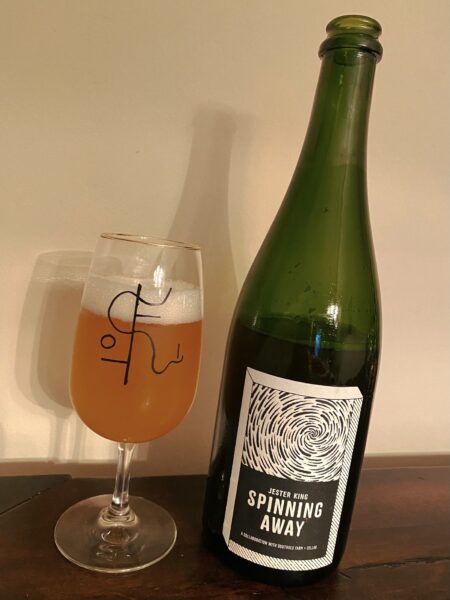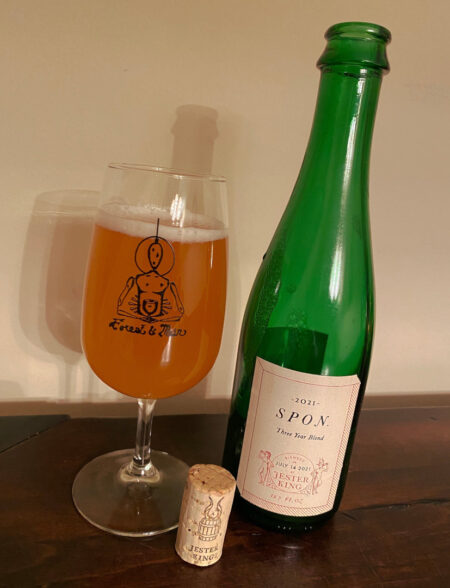As sour beers took off in the United States, most breweries took to using cultivated wild yeasts and bacterial beasties to generate a more controlled approach. However, a few breweries attempted to harken back to Belgian roots of spontaneous fermentation. Allagash set up a coolship and started building up their house style, De Garde went so far as to rely solely on spontaneous fermentation for all their beer, and then there’s Jester King.
They make lots of good stuff, but they do seem to really appreciate the traditional lambic approach, to the point where they actually defined a generalized certification for what they call “Méthode Traditionelle.” The idea was to make a mark that could be placed on any brewery’s beers that were made according to a specific set of rules. Big surprise, this didn’t go over too well with just about anyone. Belgian Lambic producers objected to their original name (“Méthode Gueuze”) because the terms Lambic and Gueuze refer to beers native to the Senne Valley in Belgium, so Jester King compromised to “Méthode Traditionelle.” Then American brewers objected, claiming that the whole thing represented a gatekeeping attempt and was blatant rent-seeking or something.
None of which really matters anymore, because people seem less interested in these complex beers patiently crafted over several years in favor of kettle sours made with so much unfermented fruit that they no longer resemble beer at all, and oh, if you leave them unrefrigerated they’ll explode, spraying juicy shrapnel all over your house.
Um, anyway, Spinning Away is one of Jester King’s spontaneously fermented beers. Made in collaboration with a local Texas winery, they basically just dropped off their coolship at the winery, dumped some wort in there, left it out overnight, then trucked the inoculated wort back to their brewery, where they put it in barrels for a couple years. The resulting blend is pretty fantasic:

Jester King Spinning Away – Pours a hazy golden yellow color with a finger or two of fluffy white head and good retention. Smells great, lots of earthy barnyard funk, hay, tart fruit, lemons, and the like, plenty of oak, very Geuze-like. Taste starts sweet, stone fruit, lemons, hits some sour notes, and then the oak and funk bring it home, finishing on that tart note again. Mouthfeel is well carbonated, light bodied, crisp, and refreshing; well balanced too. Overall, this is a very nice take on American not-lambic lambic. A-
Beer Nerd Details: 4.5% ABV bottled (750 ml corked and capped). Drank out of a flute glass on 8/20/21. Blend 1 – March 2021.

Jester King Spon Three Year Blend – This is basically American not-gueuze gueuze. A blend of three different vintages (2018, 2019, and 2020) of 100% spontaneously fermented beer. Wheat in the grain bill, aged-hops, basically the same method (Méthode!) as Belgian counterparts. And it tastes pretty fantastic. You get the complexities of aging, oakiness, it’s tart but with plenty of earthy funk. This isn’t something that will melt your teeth enamel, so it’s well balanced and a great pairing with sushi. I didn’t take formal tasting notes, because I already bored you to tears with the previous tasting notes that I wrote half a year ago, so you just get me rambling about this beer here. Which, like, has to be more interesting than tasting notes, right? How many ways to say that this is tart, earthy, tasty stuff, right? Really good, worth seeking out, would buy again. A-
Beer Nerd Details: 5.4% ABV bottled (375 ml corked and capped). Drank out of a flute glass on 2/11/22. Blended on July 14, 2021.
Wow, I’ve really been slacking on these posts, haven’t I? This one started in August of last year, and while I’ve been assiduously working on it since then, it really shouldn’t take this long. On the other hand, by “assiduously working”, I mean that I opened the post tonight and stream of consciousnessed the whole thing (with extensive research thanks to my assistant, Google). Anywho, more to come. Hopefully we can average more than one post every few months.